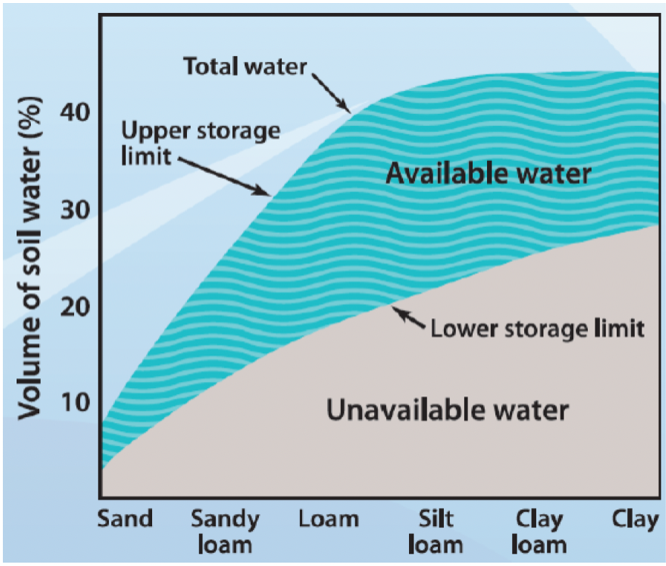Saving Water with Biochar
Remark: The references mentioned in square brackets [ ] relate to the references used in the scientific report of dr. Arnold on the Biochar Calculator. You will find these references under References. The text is an excerpt of the scientific report.
EASY READING SUMMARY
Biochar used as an aid to improve soil water retention will be even more important than the effect of improved nutrient supply to the crops. This applies especially to regions where long-lasting droughts are threatening the continuation of crop farming, if irrigation water availability is sparse or even no longer given. The positive effects of biochar on water retention, however, depend on the soil type and local climate conditions.
On average 15% in water retention capacity of biochar-treated soils can be concluded from the studies mentioned here. From an economic point of view, this benefit is reflected less in an increase in yield than in a reduction of risk of total crop failure from periods of drought and extreme heat.
Increase of Soil Water Retention
It is possible that the economic advantage of biochar uses as an aid to improving soil water retention will be even more important than the effect of improved nutrient supply to the crops in regions where long-lasting droughts are threatening the continuation of crop farming if irrigation water availability is sparse or even no longer given. The predicted impacts of climate change, droughts and raised temperatures in California are highly heterogeneous [ 31 ]. According to some model predictions, some sensitive crops, like e.g., avocados, strawberries, and other may no longer be producible in California by mid of the century. In contrast to this, other crops like e.g., almonds seem to be not afflicted. Anyhow, the impact of biochar on soil’s water retention capacity is particularly helpful for cultivation areas that have already suffered considerably from the effects of prolonged periods of drought and heat in recent years.

Fig. 2: Influence of soil texture type on available water capacity and unavailable water content below wilting point (source: [ 129 ])
There are numerous recent studies and publications on the impact of soil biochar to the soil’s water retention properties (see e.g. [ 73 ][ 130 ] to [ 138 ]. Among these properties (see Fig. 2) are the water holding capacity (total amount of water a soil can hold), field capacity (maximum amount of water a soil can hold), wilting point (volume of water in the soil, below which no more water can be extracted from the soil by plants), and available water-holding capacity (AWC), which is among the soil data published in the USDA NRCS web soil survey data base. Schmidt and Hagemann summarize in their review that biochar can increase the water retention capacity (AWC) and the water use efficiency of plants to a significant extent [ 73 ]. The positive effects of biochar on water retention, however, depend on the soil type and local climate conditions [ 73 ]. Wang et al. of UC Davis points out in more detail: “Our results suggest that biochar can have a limited impact on soil water retention when biochar pore volume is low, or soil texture is fine. High dosage (≥10 t/ha) of high pore volume biochar with bulky particle size (≥1 mm) can improve water retention of coarse-textured soil with limited capacity of water storage and may improve soil’s resilience during hydrological extremes.” [ 137 ]. In their study they achieved a high pore volume and specific surface area with biochar from walnut shells produced at a pyrolysis temperature of 900°C (1,652°F).
In the recent meta study by Razzaghi et al [ 130 ] a 47% increase in water-holding capacity was found for coarse-textured soils, 9% for medium-textured soils, and no significant increase for fine-textured soils. These findings confirm the results of an earlier meta-study of Omondi et al. [ 131 ] who found a biochar-induced average reduction of the bulk density by 7.6% and an average increase of AWC by 15.1%. Karhu et al. observed an AWC-increase by 11% after adding a relatively high dose of 9 Mt/ha of biochar to an agricultural soil in Finland [ 134 ].
Different results of the biochar-induced increase of the water-holding capacity in soils of different types and textures are listed in the most recent review of Vijay et al. [ 133 ]. They found values ranging from holding capacity growth rates of 9 % and 13 % (silty loam) to 19% (sandy loam) and even to 244% (red soil Australia). Are et al. [ 135 ] measured an AWC-increase by 25% compared with the unamended control field when adding poultry biochar to a sandy loam soil in Nigeria at a rate of 5 Mt/ha. The CharGrow-blog indicates that the water holding capacity is raised by 11% after adding biochar to boreal agricultural soil. Furthermore, a non-specified study is mentioned here with an increase of the water holding capacity by 370% for the treatment of sand with biochar.
On average (if the extreme increase values of sand and the zero-impacts of clay loam and clay are excluded), an increase of 9 to 25% with an average of 15% in water retention capacity of biochar-treated soils can be concluded from the studies mentioned here. From an economic point of view, this benefit is reflected less in an increase in yield than in a reduction of risk of total crop failure from periods of drought and extreme heat.
In order to assess the economic efficiency of biochar application as soil amendment, the costs of biochar need to be balanced with the reduction of risk of total crop failure and the additional yields that can be realized from the affected farmland, depending on the soil conditions and crops, and the cost reductions in terms of saving artificial fertilizers and reducing the need for irrigation (see chapters 4 to 6).
References:
This is an excerpt of dr. Arnold’s meta-study “Report on the Economics of Biochar Use in Agriculture – Focus: Farming in California”, which has been conducted for the development of the Biochar Calculator (page 45 to 49). The sited references can be found in the “Reference List” under “Downloads”.


